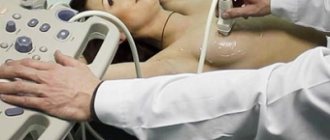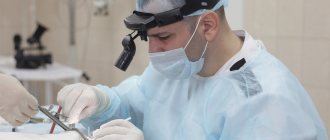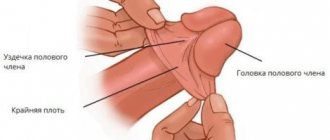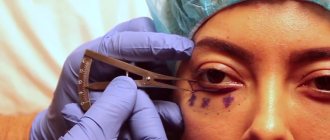Penile prosthetics (endophalloprosthetics) is the replacement of the cavernous (cavernous) bodies of the penis with functional implants, the task of which is to simulate a full erection. After their installation, neither ejaculation, nor orgasm, nor the appearance of the genital organ will be affected. A man can lead a completely normal sex life.
Indications
An erection occurs due to the blood supply to the corpora cavernosa of the penis. If during sexual arousal the blood does not flow intensely enough or does not linger in the penis (venous leakage), then erectile dysfunction is diagnosed. In most cases, the problem can be solved with conservative methods (medications, physical or psychotherapy), but for some men, penile prosthesis remains the only option. However, it should be remembered that such an operation is the final stage in the treatment of impotence, a radical way to get rid of it. The result will be irreversible; the corpora cavernosa will not recover, since only the shell remains of them.
Indications:
- Fibrosis of the corpora cavernosa, Peyronie's disease (functional tissue is replaced by connective tissue, full blood supply is impossible);
- Vasculogenic erectile dysfunction (arterial or venous insufficiency that cannot be corrected by microsurgical techniques);
- Anatomical congenital or acquired defects of the penis;
- Endocrine impotence (diabetes mellitus, congenital hormonal pathologies);
Urologist-andrologist Alexey Plekhanov on the treatment of impotence using penile replacement
- Erectile dysfunction resulting from surgical interventions on the pelvic organs, resulting in damage to nerve bundles (this often happens after removal of the prostate gland);
- Unsuccessful previous surgical interventions: revascularization (surgery on blood vessels and veins), attempts to increase the size of the penis, complications after penile replacement;
- Uncorrectable psychogenic impotence.
For psychogenic erectile dysfunction, penile prosthesis is resorted to only in cases where all conservative treatment methods have been tried, but have not yielded results.
Contraindications to penile replacement include arterial priapism - uncontrolled prolonged and painful erection, as well as active inflammation, including exacerbation of prostatitis.
Indications and contraindications
Penile prosthesis (endophalloprosthesis) is a radical method of restoring erectile function, which involves the destruction of the contents of the cavernous bodies of the penis . Removing the implants will lead to complete and irreversible impotence, since a natural erection will be impossible. For this reason, penile prosthesis is performed only in cases where all other treatment methods are meaningless or do not cause positive dynamics (as modern medicine treats impotence).
Indications for penile replacement surgery:
- Diabetes.
- Surgeries in the pelvic area resulting in serious damage to the nerve plexuses and tissues.
- Pelvic bone injuries.
Urologist-andrologist Alexey Plekhanov on the treatment of erectile dysfunction using penile prosthesis
- Pathologies leading to curvature of the penis or changes in its cavernous bodies: Peyronie's disease, penile underdevelopment, cavernous fibrosis.
- Endocrine and vascular disorders that cannot be corrected with conservative therapy.
- Ineffectiveness of reconstructive surgical interventions.
- Neurological diseases.
Incavernous penile prosthesis solves the problem of pharmacological impotence caused by the need to constantly take medications that suppress erectile function. The operation is also effective for uncorrectable psychogenic erectile dysfunction . There is no exhaustive list of indications for penile prosthesis. The decision to perform the procedure is made on the basis of diagnostic findings.
Contraindications for the installation of penile prostheses for impotence include symptomatic and arterial priapism (random painful erections), the presence of foci of infection.
Types of prostheses and their features
Modern men have a fairly wide selection of penile prostheses. Manufacturers are constantly improving their models, making them as functional and natural as possible. The only limitation is the cost.
Rigid (rigid) and semi-rigid penile prostheses
Previously, the only option for a penile prosthesis was a hard one. The model is inconvenient neither physiologically nor aesthetically. Silicone rods are sewn into the corpora cavernosa, due to which the penis remains the same size both at rest and during erection - straight when tense. That is, it looks unnatural in any case. Pros: low cost, minimal risk of breakdown, ease of installation.
Semi-rigid penile prostheses differ from previous ones by the “memory effect”. That is, they can be directed up or down (even bent under the scrotum), while the position will remain the same.
Plastic penile prosthesis AMS Spectra (two rods - one in each cavernous body)
Rigid and semi-rigid penile prostheses are installed for patients who find it difficult to fully move their hands. This can be a consequence of rheumatoid arthritis, spinal injury, or the absence of several fingers.
Inflatable (hydraulic)
Inflatable penile prostheses increase in volume for an erection and decrease in volume at rest. This effect is achieved by injecting liquid into balloons by pressing on a pump located in the scrotum (usually between the testicles) (it is ribbed and easy to feel).
Inflatable penile prostheses can be two- or three-component. In the first case, the kit includes cylinders and a silicone pump connected to them (aka a reservoir). Three-piece models include balloons, a pump and a separate reservoir (100 ml) sewn under the abdominal muscles next to the bladder.
Ambicor two-component penile prosthesis
The balloons are filled after 3-4 presses on the pump sewn into the scrotum. To deactivate the implant, you just need to bend the penis down, the liquid will flow into the reservoir itself in 6-12 seconds. Of the minuses: the penis increases in thickness insignificantly during an erection and does not completely relax in a calm state.
A three-component penile prosthesis is the most advanced option . How it works: the man presses the valve in the scrotum, liquid (sterile saline solution) from the reservoir enters the cylinders, and when the scrotum is pressed again, it is pumped back into the reservoir.
Three-piece penile prosthesis AMS 700 CX
The three-component penile prosthesis provides a high-quality imitation of a full erection: the penis noticeably increases in size and completely relaxes. Of the minuses:
- High price.
- Complex structure, which increases the risk of breakage.
- Precision of movements is required when pressing the valve. Not suitable for patients with neurological problems.
Installation of a three-component penile prosthesis is technically more complex.
Types of implants
The choice of the type of implant for penile prosthesis depends on the physiological parameters of the man, his ability to pay and personal wishes. During the consultation, the doctor invites the patient to familiarize himself with demonstration models that can be evaluated in action. Many clinics perform computer modeling that reflects the condition and size of the penis after installing one or another version of the penile prosthesis.
By design, implants are divided into 3 groups:
- Semi-rigid silicone (uncontrollable rigid) that does not change its shape and size. The penis is constantly in a state of erection, so it has to be pressed with underwear. Such models are the cheapest, but inconvenient, therefore they are currently almost never used for penile prosthetics;
- Plastic (controlled rigid) - also made of silicone, but inside there is a flexible rod that allows you to fix the position of the penile prosthesis with your hand. Examples include the AMS Spectra, Coloplast Genesis models;
- Inflatable (hydraulic) , which is a biosystem of cylinders, tubes and pumps. This is the most physiological version of the implant, providing an almost natural erection of the penis.
Plastic penile prostheses are easy to install and use, and are the best option for men with the following pathologies:
- Severe form of diabetes mellitus.
- Having a colostomy.
- Abdominal obesity.
- Diseases accompanied by impaired hand movements.
The disadvantage of semi-rigid penile prostheses is that the penis is reduced by 2-4 cm from the erect state. This is due to the lack of erection of the head and longitudinal staticity of the cylinders. Some men with reduced elasticity of the membranes of the cavernous bodies (for example, with Peyronie's disease) and the initial penis size of less than 10 cm before implantation are recommended to perform exercises to stretch it.
Most patients prefer hydraulic penile prostheses. Depending on the configuration, they can be of two types: two, and also three-component. Two-component ones (for example, AMS Ambicor) include 2 silicone inflatable cylinders (each of them is placed in the cavernous body of the penis) and a pump implanted into the scrotum. The structure is communicated through flexible silicone tubes. The pump and cylinders are partially filled with sterile saline solution, which is why the penis never goes completely limp. When you press on the scrotum (3-5 times), the liquid fills the cylinders, they increase in size, providing a full erection. After sexual intercourse, you need to press the pump valve once and lightly squeeze the penis.
In three-component penile prostheses (AMS 700 CX or AMS-700LGX), a liquid reservoir (60-75 ml) is included in the package. Thanks to this, the penis becomes completely relaxed after sexual intercourse, which eliminates unnecessary tension on its tissues and bedsores. The reservoir is placed behind the pubic bone without causing any discomfort to the man. In the Titan OTR model from Coloplast, 1 press on the pump is enough to activate.
The non-return valve, which is equipped with modern penile prostheses, eliminates spontaneous filling of the cylinders . Controlling the pump when installed correctly (preferably in a designated pocket of the scrotum, and not between the testicles) is not difficult. When placing a pump between the testicles, problems often arise with finding it, especially in men with obesity, hydrocele, or inguinal hernia.
Andrologist, Doctor of Medical Sciences Akhvlediani Nika Dzumberovich talks about the design of the most common implants
The latest generation of hydraulic penile prostheses last for 20 years. The structures are highly reliable, so there is no need for reimplantation before the end of their service life. AMS and Coloplast provide a lifetime warranty on their models. Products from these manufacturers have additional protection against infection: AMS has a patented antibacterial shell, Coloplast has a porous coating impregnated with antiseptics.
After penile prosthetics with some hydraulic models, the penis also loses 1-2 cm in length. But in modern implants (AMS-700LGX), the cylinders increase not only across, but also along, which allows you to increase the size of the penis.
Preparing for surgery
First, the patient is consulted by a surgeon. Its task is to objectively assess the need for penile prosthesis. To confirm the indications, he may prescribe a series of studies that help determine the condition of the cavernous bodies and the blood flow in them:
- Cavernosography;
- Cavernosometry;
- Papaverine test;
- Ultrasound of the member.
Dopplerography of the vessels of the penis
Penile prosthesis (especially with three-component prostheses) is a full-fledged surgical intervention performed under spinal anesthesia, so preparation includes passing a standard set of tests: blood, urine, ECG. A conversation with an anesthesiologist is required. Based on the results of all studies, the doctor selects a suitable model of penile prosthesis; the size of the rods (balloons) is selected directly during the operation after measuring the cavernous bodies.
On the eve of the operation, it is necessary to remove hair from the pubis and lower abdomen (when installing a three-component penile prosthesis). You should not eat food 8 hours before prosthetics. Immediately before the operation, the surgical area is treated with antiseptic.
Preparation for penile prosthesis
The preparation program for penile prosthesis includes:
- Urine and blood analysis;
- Ultrasound of the peritoneum, penis, scrotum;
- Assessment of the condition of the pelvic vessels and penis;
- Conversation with an anesthesiologist.
Ultrasound of the tissues and vessels of the penis
The doctor is interested in any information regarding the presence or recent treatment of infectious foci. For example, there is a known case of implant rejection a year after penile replacement. The reason is the concealment of information about surgical intervention for purulent periodontitis, performed 5 days before the operation.
To prevent prosthetic infection, the following protocol is followed before performing penile prosthesis :
- Preventive antibiotic therapy (one day before surgery).
- Wash the patient's body with an antiseptic (the evening before surgery).
- Shaving the surgical area around the penis and antiseptic treatment.
On the day before the penile prosthesis procedure, the patient does not eat or drink anything. It is advisable to minimize food intake during the day, so that during the operation you do not cause problems with the gastrointestinal tract, which is relaxed from anesthesia (possible reflux of contents into the respiratory tract).
How is the operation performed?
The course of the operation depends on the type of prosthesis installed. An incision is made in the area of the scrotum to gain access to the corpora cavernosa, then they are expanded using a special instrument and the length is measured. Below we will show three operations for installing semi-rigid, two- and three-component penile prostheses. If you are over 18 years old, you can follow the links:
- Installation of a semi-rigid prosthesis AMS-650 - https://yadi.sk/i/LgopSR8mtONYtg;
- An example of implantation of a two-component Ambicor implant - https://yadi.sk/i/_u4xv04c98p2KQ;
- An example of installation of a three-component penile prosthesis Alfa (Mentor) - https://yadi.sk/i/wRXbadCwKIQyxg.
The operation lasts 1-1.5 hours. On the fifth day the patient is discharged. He must take antibiotics for a week. For one and a half months, sexual rest and periodic preventive activation of the cylinders are necessary.
Video illustrating the installation of a three-component penile prosthesis
Postoperative period
The first days after surgery are the most difficult. On the first day, you will feel discomfort in the area of the scrotum and penis. It will intensify when sitting and walking. The penile prosthesis is activated by the doctor from the moment the operation is completed until the morning of the next day. During the first dressing, it will be deflated and the drainage from the scrotum will be removed. The process of deactivating the prosthesis will be painful. On the second day, the doctor will make a dressing; there will be no manipulations with the prosthesis. The pain gradually decreases. After 10-12 days, the stitches will be removed.
Upon discharge, the doctor will explain in detail how and for how long you need to activate the penile prosthesis. The sensations after penile prosthesis are different for everyone. They get used to the three-component ones the fastest.
Implants rarely break - in about 10% of cases after 10 years of service. Products from AMS and Coloplast will last about 25 years.
Recovery of a man after penile prosthesis.
Life after penile prosthesis. The first days after surgery will be the most difficult. It is for this reason that it was decided to publish an article devoted to the issue of rehabilitation of men who underwent penile prosthesis. In which I will describe in detail the general condition, complaints and sensations that most men experience in the first three days after penile prosthesis.
- FIRST DAYS after penile prosthesis. The day after surgery, the patient may feel discomfort in the perineum, scrotum and shaft of the penis. The discomfort may increase and become painful when sitting (especially on soft surfaces) or when walking.
- In order to prevent postoperative bleeding, upon completion of implantation of a three-component hydraulic implant (Coloplas or AMS), the implant is activated until the next morning.
- The first dressing after penile prosthesis involves changing the dressing and deactivating the implant (the doctor will reduce the pressure in the implant cylinders). The process may be accompanied by unpleasant and painful sensations.
- After the implant is deactivated, the doctor will remove the drainage from the scrotum. Drainage is a device that allows you to clean the surgical area from wound discharge and blood, and prevents the formation of hematomas. The removal process is almost painless.
- It is important to understand that on the first post-operative morning, any pressure on the pump (located in the scrotum) and on the cylinders of the penis (located in the shaft of the penis) will be painful or extremely unpleasant, which is normal.
- SECOND DAY after penile prosthesis. The second dressing is less painful, since no manipulation of the implant occurred. It involves treating the surgical area with an antiseptic solution and changing a sterile dressing.
- It is important to understand that on the first post-operative morning, any pressure on the pump (located in the scrotum) and on the cylinders of the penis (located in the shaft of the penis) will be painful or extremely unpleasant, which is normal.
- THIRD DAY after penile prosthesis. Pain and discomfort noticeably subside even in a sitting position and when lifting. With each subsequent day, pain symptoms will noticeably decrease until they disappear completely. Postoperative sutures will be removed on days 10-12.
- At the time of discharge, the doctor must instruct the patient in detail about how and when to activate and deactivate the implant. How and by how much to increase the duration of activation, what you need to pay attention to when resuming sexual activity.
Sexual life after penile prosthesis. Following all the specialist’s recommendations, it is possible to begin sexual activity within 1.5 months after surgical treatment. It is this nature of time that is required to restore the integrity and healing of the inner membranes of the penis. Penile prosthesis does not affect urination, orgasm, ejaculation and reproductive function of a man!
ALL ABOUT PENAL PROSTHETICS
PHOTOS OF ALL STAGES OF THE PENTAL PROSTHETICS OPERATION
APPEARANCE OF THE PENIS AFTER PENAL PROSTHETICS
Consequences
Basically, penile replacement goes without problems. Complications occur in only 4% of cases. It could be:
- Infectious inflammation;
- Displacement of the prosthesis;
- Allergic reaction;
- Hematomas and swelling of the penis;
- Tissue necrosis due to an incorrectly selected prosthesis;
- Damage to the urethra.
Necrosis of the tunica albuginea can occur, for example, in the case when a man forgot to deactivate the prosthesis and walked with it for several days.
If the pain does not subside within 2 weeks, the redness and swelling do not go away, then non-engraftment is evident. Dentures will need to be removed and cleaned. After some time, you will have to do reprosthetics.
Patients should take into account that after installing a penile prosthesis, the length of the penis will decrease by 1-2 cm. This is due to stretching of the tissues on the cylinders.
How to choose a penile prosthesis?
There are hydraulic, semi-solid and solid implants. The most popular are hydraulic penile prostheses, which are comfortable, look natural and have no side effects. Two soft cylinders are implanted into the cavernous bodies of the penis, which are connected by tubes to a pump and reservoir. When you press the pump, sterile water from the reservoir fills the cylinders, making them hard, as with a natural erection.
Hydraulic prostheses come in three- and two-component types. In the latter, the pump reservoir is located in the scrotum. In three-component ones, the reservoir is placed behind the pubis, and the pressure pump is in the scrotum.
Semi-rigid implants have good mechanical strength, but are somewhat uncomfortable in everyday life. There is a risk of perforation and outward migration of the prosthesis. This penile prosthesis consists of two multilayer silicone cylinders connected to each other by silver wire.
Rigid penile prostheses are not used in modern medical centers. They are completely uncomfortable and lead to complications due to constant pressure on the tissue of the penis.
When can you start having sex?
You can have sex no earlier than 1.5-2 months after surgery . It is necessary for all internal tissues of the penis to heal. Otherwise, there is a risk of displacement of the prosthesis, the appearance of suppuration, swelling, hematomas, and rejection of the prosthesis.
After the end of the recovery period, there are no obstacles to a normal intimate life. The sensitivity of the penis will not be affected in any way, since the nerve trunks are not damaged. For some, in the first months or even a year, the sensitivity of the head may decrease slightly, but this effect is temporary.
Penile prosthetics will also not affect the function of childbearing. The composition of sperm is preserved if the prostate is not touched.
How is penile prosthetics performed and what is the prognosis for the operation?
Penile prosthesis is a drastic, but one of the most effective methods of treating impotence
The problem of impotence in men is becoming increasingly relevant these days. Alas, sad statistics tell us that by the age of forty, about 20% of the male population of Russia suffers from sexual weakness.
Unfortunately, even between the ages of 20 and 40, 10% of men report some kind of potency and erection disorder.
The absolute indications for surgery are:
- Consequences of surgical operations on the penis, rectum, prostate gland and bladder.
- Vascular erectile dysfunction is refractory to drug therapy.
- Impotence in Peyronie's disease.
- Impotence in severe diabetes mellitus.
- Congenital dysfunctions and (or) underdevelopment of the penis. Penile atrophy.
- Fibrous lesion of the penile caverns.
- Psychogenic impotence when its treatment is ineffective by other methods.
In all cases, the active position of the patient himself and his desire to undergo surgery are necessary.
It must be remembered that if a man is diagnosed with impotence, this does not mean that he immediately needs to have implants inserted.
Of all the above, only penile prosthesis is a radical method that allows for a complete cure of impotence. All others give only a temporary symptomatic effect.
The procedure can cause complications, so you need to carefully weigh the pros and cons when deciding on surgery.
The patient needs:
- Undergo a full examination to exclude diseases such as tuberculosis, cancer, sexually transmitted diseases, and cardiovascular pathologies in the decompensation stage.
- Be completely sure that other treatments for erectile dysfunction are not working.
- Undergo psychological training. Realize that prosthetic implants remain for life; they cannot be removed and the natural cavernous bodies restored.
Since the operation is performed under general anesthesia, you should not drink or eat food in the morning before the operation. The maximum allowed time for dinner the day before should be checked with your doctor.
There are the following types of prostheses that are inserted into the spaces of the cavernous bodies:
- Rigid models consisting of two rods, most often made of silicone, but without the so-called plastic memory. They were used at the dawn of prosthetics. Their advantages are simplicity and low cost. Disadvantage: constant tension of the penis. The shape of the penis cannot be “adjusted” manually. Creating a lot of inconvenience in everyday life and psychologically, they are more dangerous due to postoperative complications.
- Plastic semi-rigid models with memory. They contain additional wire bundles, ensuring the desired position of the penis. The man independently brings the penis into a “fighting” state and, after completing sexual intercourse, lowers it with his hand. The main disadvantage of this method is that the penis remains constantly hard.
- Hydraulic two- and three-component penile prostheses with a pump attached to them that pumps and drains fluid. The implants are implanted into the corpora cavernosa, and the pump is installed in the scrotum. The man activates the pump by pressing in a certain place, and the penis rises due to the fluid expanding the implants. After the end of sexual contact, you should press in another place, and the fluid returns back, and the penis lowers. The method brings sexual intercourse as close as possible to physiological. The partner may not even notice the consequences of the operation in the man.
After the operation, the patient remains in the hospital for about 10 days. You can return to sexual activity in six months.
The dildo implant consists of 2 cylinders (1), which are installed in the cavernous bodies of the penis, a fluid reservoir in the pelvis (2) and a pump, which is placed in the scrotum (3)
The operation is contraindicated for:
- priapism (pathologically long erection);
- urinary tract infections;
- severe concomitant diseases.
A relative contraindication is the ability to restore an erection conservatively.
Penile prosthetics, like any surgical operation, requires careful adherence to all necessary measures in the postoperative period. Strict bed rest is prescribed for two days.
Antibiotics are used to suppress postoperative inflammation and prevent infection. In the first 7-10 days after implantation, significant pain and swelling of the penis is possible.
This is a normal condition; conventional analgesics are prescribed to relieve pain.
In the long term, incorrectly selected prostheses can compress the head of the penis and cause its necrosis.
Therefore, if a man, after starting sexual activity with a prosthesis, feels pain and numbness in the genital organ, he should definitely consult a doctor.
Forecast
It should be borne in mind that after ten years, up to 20% of penile prostheses fail. The condition requires mandatory re-operation; an erection cannot be restored on its own.
In general, penile prosthetics allows almost doomed patients to restore their sexual life.
Already two months after the operation, sexual contacts are allowed. Constant medical supervision is not required.
Men retain the sensitivity of the genital organ, while independent control of the duration of sexual intercourse gives the additional opportunity to fully satisfy the partner.
Read: Using cock rings for sexual intercourse
Doctors rating
On thematic men's forums, three specialists are most often recommended:
- Menshchikov Konstantin Anatolyevich (genital-clinic.ru);
- Petrovich Ruslan Yuryevich (www.andro-forum.ru);
- Sokolshchik Mikhail Mironovich (www.mdsokol.ru).
The above doctors are accepted in Moscow. Known for their own developments of genital surgery techniques.
Penile prosthesis price
Examples of prices for penile prosthetics in Moscow and St. Petersburg:
- University Clinic of Moscow State University (Moscow): installation of a semi-rigid prosthesis - 140 thousand rubles, three-component - 250 thousand rubles. (excluding prosthesis).
- Clinic "Andros" (St. Petersburg): one-component penile prosthesis - 94 thousand rubles, two-component - 158 thousand rubles, three-component - from 188 thousand rubles. All without taking into account the price of the prosthesis.
- L-Clinic (Moscow, Khimki (Dr. Menshchikov)). The cost of the turnkey operation with a seasonal discount (room for two days, consultation, activation of the prosthesis, dressings): three-component – 120 thousand rubles, one-component – 95 thousand rubles.
- Moscow Clinical Center for Microsurgery on Ivankovskoye Shosse, 3 (Dr. Sokolshchik): single-component penile prosthesis - 110 thousand rubles, two- and three-component - 158 thousand rubles. + consumables from 280 to 550 thousand rubles.
The penile prostheses themselves are not cheap, for example:
- Three-component Coloplast Titan Touch – 395 thousand rubles;
- Three-component AMS 700 Cx – 320 thousand rubles;
- One-component Coloplast Genesis – 95 thousand rubles.
The real price for penile prosthetics with expensive implants in a private clinic can reach 1 million rubles. taking into account the stay in the ward, tests and rehabilitation.
According to the quota (compulsory medical insurance policy), only penile prosthetics with a one-component implant can be performed. Such services are provided by the Urology Clinic named after. Fronshteina (Moscow), Clinical Hospital No. 122 (St. Petersburg).
Reviews from patients after surgery
Andrey, 59 years old: “I installed the AMS-700 CX prosthesis at the Andros clinic (St. Petersburg) with Plekhanov. The operation went well, after a couple of days he was discharged, but he began to have sexual activity only after 2 months. So far everything is fine. The only thing is that the head has become a little less sensitive.”
Anton, 44 years old: “I developed impotence early due to cavernitis, I had to undergo penile prosthetics. The operation is expensive, so I installed the simplest prostheses according to the quota. It was painful to sit for almost a month, I took antibiotics, I lost weight, but then all the problems with my intimate life disappeared. In ordinary life I just put my penis along my leg, it’s not visible in loose trousers.”










